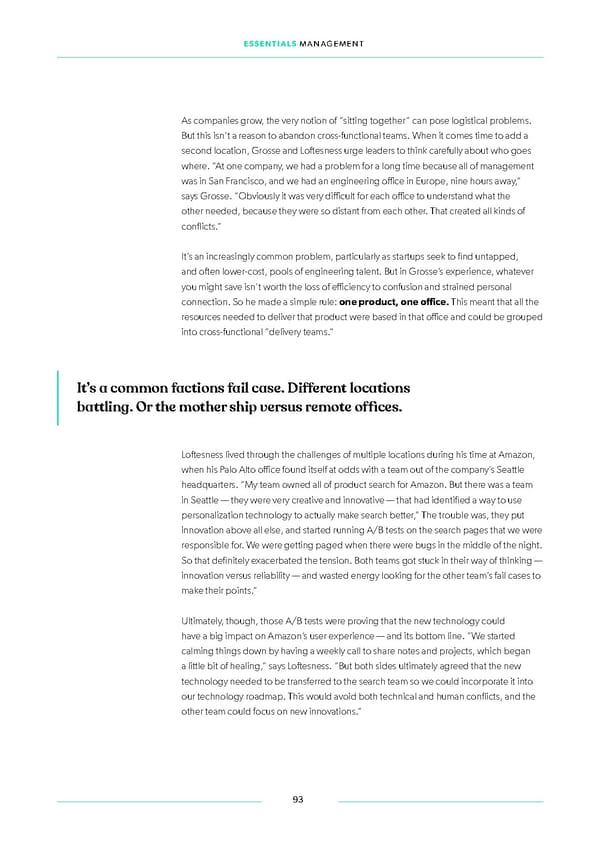ESSENTIALS MANAGEMENT As companies grow, the very notion of “sitting together” can pose logistical problems. But this isn’t a reason to abandon cross-functional teams. When it comes time to add a second location, Grosse and Lotfesness urge leaders to think carefully about who goes where. “At one company, we had a problem for a long time because all of management was in San Francisco, and we had an engineering oiffce in Europe, nine hours away,” says Grosse. “Obviously it was very diiffcult for each oiffce to understand what the other needed, because they were so distant from each other. That created all kinds of conlficts.” It’s an increasingly common problem, particularly as startups seek to ifnd untapped, and otfen lower-cost, pools of engineering talent. But in Grosse’s experience, whatever you might save isn’t worth the loss of eiffciency to confusion and strained personal connection. So he made a simple rule: one product, one oiffce. This meant that all the resources needed to deliver that product were based in that oiffce and could be grouped into cross-functional “delivery teams.” It’s a common factions fail case. Different locations battling. Or the mother ship versus remote ofifces. Lotfesness lived through the challenges of multiple locations during his time at Amazon, when his Palo Alto oiffce found itself at odds with a team out of the company’s Seattle headquarters. “My team owned all of product search for Amazon. But there was a team in Seattle — they were very creative and innovative — that had identiifed a way to use personalization technology to actually make search better,” The trouble was, they put innovation above all else, and started running A/B tests on the search pages that we were responsible for. We were getting paged when there were bugs in the middle of the night. So that deifnitely exacerbated the tension. Both teams got stuck in their way of thinking — innovation versus reliability — and wasted energy looking for the other team’s fail cases to make their points.” Ultimately, though, those A/B tests were proving that the new technology could have a big impact on Amazon’s user experience — and its bottom line. “We started calming things down by having a weekly call to share notes and projects, which began a little bit of healing,” says Lotfesness. “But both sides ultimately agreed that the new technology needed to be transferred to the search team so we could incorporate it into our technology roadmap. This would avoid both technical and human conlficts, and the other team could focus on new innovations.” 93
 Essentials Management First Round Capital Page 92 Page 94
Essentials Management First Round Capital Page 92 Page 94